跨文化交际论文题目
- 格式:doc
- 大小:22.00 KB
- 文档页数:3
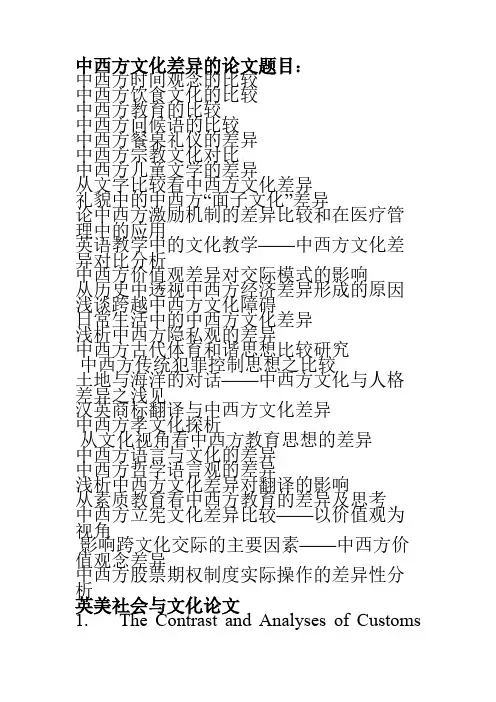
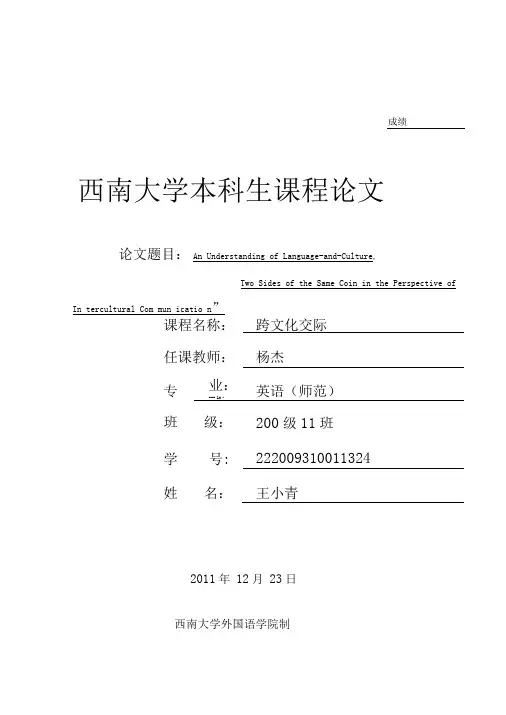
成绩西南大学本科生课程论文论文题目:An Understanding of Language-and-Culture,Two Sides of the Same Coin in the Perspective of In tercultural Com mun icatio n”课程名称:跨文化交际任课教师:杨杰英语(师范)专业:--- L K •班级:200级11班学号: 222009310011324姓名:王小青2011年12月23日西南大学外国语学院制An Understanding ofLanguage-and-Culture, Two Sides of the Same Coin in the Perspective ofIntercultural C ommunication ”WANG XiaoqingAbstract: As we all know, we express our thoughts by means of language. However, while we using language, we convey culture at the same time. As for color, it ' s a partlaofnguage, soit including culture, too. There are differencesin the use of colors and color words between Chinese and English cultures. The different cultures bring different attitudes toward the same color because of different culture background, they reveal wide connotation of cultures. We should pay attention to observing not only their basic meanings, but also the deep and broad symbolic meanings. The symbolic meanings of color words often have different features in different language cultures. And some of them even have become taboos and adornments since the meanings of the color words are extended and transferred. Meanwhile, the cultural exchanges and the color views have similar phenomenon and coincidence in the languages.Key Words: Color words; cultural differences; symbolic meanings; comparisonI.IntroductionColor is an important part of our life. Color words help us to understand the world around, like our sense of taste and smell. The basic color words in English such as red, yellow, white, black, not only express the colors of objective things, but also the obstruct things. The color words have specified semantic meanings in different cultures. Without understanding of them, we will probably run into obstacles or make a fun of ourselves in communication. Therefore learning and grasping the symbolic meanings of color words are important. Good understanding of the symbolic meanings of color words can help us communicate effectively among people from different countries. This paper tries to illustrate the different symbolic meanings of color words in Chinese and English cultures by comparison and analysis of them.II.Color and CultureColor words, in whatever languages, are used for describing different things. The statistics show that there are more than 7 million kinds of colors can be recognized in the nature. However, the color names are very limited in the languages because there are only dozens of colorsexpressed in single-morpheme word. A number of color words are expressed by adding modifiers, for instance, crimson, pale red, apple green, azure, coffee color etc. Color words reflect the different culturalconnotations in different languages. People regard color words with special esteem in different countries. We should not only understand their basic meanings, but also pay attention to their deeply symbolic meanings. The symbolic meanings of color words have different features in different cultures.III. Different Meanings of Same Color in Different Cultures A.RedIn Chinese culture, the color of red is popular for special events, holidays and ceremonials.In ancient times, when people got married, the bride always dressed in red, and wore“ Hongtouga (红头盖)” .The bridegroom always tied a red ribbon and wore a red flower in the front. And almost everything in the wedding had something to do with red color. Neolithic hunter considered red to be the most important color endowed with life —giving powers and placed red ochre into graves of their deceased. Neolithic cave painters ascribed magic power to the red color.It can be stipulated that they painted animals in red ochre or iron oxide to conjure their fertility. It is usually believed in China that red can against evil influence.Nevertheless, to Wester ners, “ red is usually related to dan ger, war, blood, terror andsensuality. When the traffic lights turn red, it means danger and pause. Red card is widely used to punish players who act badly in sports and games. connotation meaning is libidinous or flagrant. Up tonations still implies whorehouse.B. WhiteChinese people abandon and disgust in both material and spiritual aspects. White symbolizes the death and ill omen in Chinese culture. The relative must wear mourning for the death of parents and relatives since ancient times. They worn the white mourning dress, and it is called the funeral. The relatives set up the white mourning hall. And they should hit the white long narrow flag while carrying a coffin to the cemetery.In English culture, the symbolic meanings of white color focus on color itself, such assnow, fresh milk and the color of lily. Westerners think white stands for grace and purity. When a woman wears a white wedding dress, she is a virgin. Sometimes a woman who is getting married for the second time she may not wear pure white. She may wear off-white or even some other color. On Christmas Day white-colored ornaments are seen everywhere in decorating Christmas trees and houses in most Western countries.C. BlackThe color of black has seriously mysterious senses in Chinese culture. It is a kind of serious tone. Its symbolic meaning seems comparatively complicated for the influence of Western culture.On one hand, it symbolizes serious, justice such as black face Bao Zheng in the popular legend,Scarlet is the color of bright red, yetits White and red are opposite in Chinese culture. White is a basic taboo word that reflectsblack types of facial make up of Zhang Fei, li Kui in traditional Beijing opera, etc; On other hand,it symbolizes evilly, reactionary, such as vicious person is a black heart, hidden repulsive inside shady deal ”, evil backstage manipulator; it showscchriamsed, osubandit conduct shout “walktheunderworld ”do, illegal inn of business named the gangster, the violated goods trade iscalled the black market. Black is also used to name the dirty money that the money is obtained by illegal means.Black is a basic taboo color in Western culture. Black reflects spiritual abandoning anddisgust of Westerner. It symbolizes the death, ill omen, and disaster, for example, Black Mass fits 's death, black words are uthnelufciekrycewodradys,is ablack letter day; black symbolizes the evilness, crime, such as Blackman, a black deed, blackguard,andblackmail; it symbolizes shame, inglorious too, for instances a black eye, a black mark, and black sheep; it symbolizes angry, depressed such as black dog is the depressed mood, the future looks black means prospects are dim, he gave me a black look means he is looking at me in a great rage.D. YellowIn Chinese culture, “ yellow ” originally represents the colors of the soil. In book 《说文》 : Yellow is the color of the earth. ” In Webster ' s Dictionary of the English Language, yellow isexplained as the colors of gold, butter, and ripe lemon. The Y ellow Highlands, lying by the Y ellowRiverside is one of the most important cradle lands of the Chinese people. It is from Y ellow River that the Chinese ancient culture came into being. The ancient Chinese people mainly depended onthe land to live and breed from generations to generations. Chinese and English countries use different colors to express “powerand honor ”.InChina, “ yellow i ”s alwaysconnected with “honor ” and “gloisrythe ”s,ymanbdolitofare many words such as “ Huangpao (黄袍)” ,“ Huangbang (黄榜)”,Chinese language.But in English countries, it is “purpleno ”t “ yellow th ”at is usually associated with “highrank ” or “imperial ” or “power ” in particularly. Meanwhile, many of the roofs such as the Imperial Palace, Shrines and royal buildings choseyellow color for decorations. Y ellow is generally related to something pornographic in Chinese, such as “黄色电影” , “黄色书刊” , “黄色音乐” and so on. If we translate these phrases into yellow movies, yellow book and yellow music, it will be strange because “ yellow ” has nothing to do with filthy at all in English culture. We can use pornographic, decadent, trashy, or vulgar for Chinese “黄” . Thereby, “黄色电影” in English we can say pornographic pictures, blue movies; “黄色书刊” filthy books, pornographic books.IV. ConclusionThrough the analysis above, this paper shows that the symbolic meaningsof color words between English and Chinese cultures have divergences; both ofthem have some common features's impossiblellttohelispt oaints in colors between western and Chinese culture.information is fairy Mass, to wear black for her father an honorable color. It is “ power ” and “ lofty ”. There“Huangmen(黄门)” in in some aspects. ItAll we need to do is to learn the knowledge about colors as much as possible.Notes[1] Palmer, P.R. Semantics. Cambridge: Cambridge University Press, 1983.[2] Seidl, J. and McMorde, W. English Idioms and How to Use Them. Oxford University Press, 1978.[3] 安俊丽 . 黄色彩对汉语词汇的文化影响 [J]. 安庆师范学院学报, [4] 方梦之 . 汉英翻译基础教程 [M] .北京:中国对外翻译出版公司,[5] 陆国强. 英汉和汉英语义结构对比 [M] .上海:复旦大学出版社,[6] 陆谷孙. 英汉大词典 [M] .上海:上海译文出版社, 1993.[7] 蒙兴灿,孔令翠 .实用汉英翻译 [M] .成都:四川大学出版社,2002. [8] 万昌盛.色彩的困惑一一翻译札记[J].中国翻译,1991 , (3). 2002 ,(9)2005 1999。
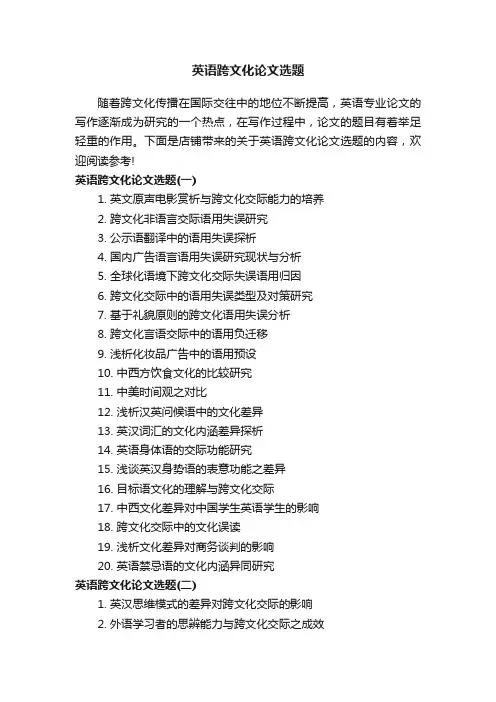
英语跨文化论文选题随着跨文化传播在国际交往中的地位不断提高,英语专业论文的写作逐渐成为研究的一个热点,在写作过程中,论文的题目有着举足轻重的作用。
下面是店铺带来的关于英语跨文化论文选题的内容,欢迎阅读参考!英语跨文化论文选题(一)1. 英文原声电影赏析与跨文化交际能力的培养2. 跨文化非语言交际语用失误研究3. 公示语翻译中的语用失误探析4. 国内广告语言语用失误研究现状与分析5. 全球化语境下跨文化交际失误语用归因6. 跨文化交际中的语用失误类型及对策研究7. 基于礼貌原则的跨文化语用失误分析8. 跨文化言语交际中的语用负迁移9. 浅析化妆品广告中的语用预设10. 中西方饮食文化的比较研究11. 中美时间观之对比12. 浅析汉英问候语中的文化差异13. 英汉词汇的文化内涵差异探析14. 英语身体语的交际功能研究15. 浅谈英汉身势语的表意功能之差异16. 目标语文化的理解与跨文化交际17. 中西文化差异对中国学生英语学生的影响18. 跨文化交际中的文化误读19. 浅析文化差异对商务谈判的影响20. 英语禁忌语的文化内涵异同研究英语跨文化论文选题(二)1. 英汉思维模式的差异对跨文化交际的影响2. 外语学习者的思辨能力与跨文化交际之成效3. 培养英语学习者跨文化交际能力之策略4. 英汉道歉语差异及原因5. 中西跨文化礼貌语差异探析6. 英汉语言中礼貌表达法之比较7. 英汉习惯用语的文化内涵探源8. 英语称赞语及其回应的异同研究9. 中美(西)家庭教育理念的差异及其对孩子的影响10. 中国英语学习者跨文化交际中的主要障碍研究11. 试析跨文化交际中角色互动的作用12. 本土文化与异国文化的冲突对跨文化交际的影响13. 跨文化交际中的时间观差异14. 论跨文化交际中的中西餐桌礼仪15. 关于提升英语专业学生跨文化交际能力的培养16. 涉外婚姻中的中西文化冲突17. 论跨文化广告传播中食品商标的翻译18. 多媒体教学与跨文化交际能力的培养19. 中西方儿童文学的差异20. 中西体育文化的差异及其受全球化发展的影响21. 中西传统休闲文化及其价值观的对比分析22. 简爱与林黛玉不同命运的文化透析23. 国际商务活动中礼貌原则的应用英语跨文化论文选题(三)1. 从中英文动物比喻的不同看中西文化差异2. 英汉概念隐喻的文化认知对比分析3. 英汉成语文化内涵比较研究4. 从神话看中西文化异同5. 文化视角下英汉时间隐喻比较研究6. 英汉情感隐喻文化内涵对比研究7. 从文化语境看英汉爱情隐喻8. 英汉动物隐喻的文化内涵9. 论中英文中颜色隐喻的差异及其文化根源10. 英汉习语中中西文化差异探源11. 从英汉委婉语中看中西文化心理差异12. 文化视阈中的汉英典故13. 美国俚语的基本特征与社会功能14. 从旅游广告看中西文化差异15. 英语学习中中国文化缺失对跨文化交际能力的影响16. 正视中西文化冲突提高跨文化交际能力17. 从跨文化交际中的语用负迁移反思英语教学18. 情境教学法在跨文化交际教学中的应用19. 从跨文化交际的角度解读中西方礼貌准则和策略20. 英汉委婉语及其在跨文化交际中的21. 英语教学中学生跨文化交际能力的培养22. 跨文化交际中的饮食文化差异23. 从集体主义和个人主义看国际商务谈判的文化差异24. 中英礼貌用语之差异25. 过渡语僵化现象文化因素成因26. 跨文化交际中的美国个人主义27. 英汉隐喻的文化背景差异研究28. 中英礼貌用语研究综述29. 颜色词的文化内涵30. 中国茶文化与西方咖啡文化对比研究31. 汉英称谓语中的文化差异32. 民俗风情游--中西“水”文化之比较33. 跨文化商务谈判中的文化适应34. 跨文化交际中的空间观35. 英汉习语的文化差异分析36. 当代中美女性婚姻观的比较研究37. 中美商务谈判礼仪之礼貌用语比较。

1. 英文原声电影赏析与跨文化交际能力的培养2. 跨文化非语言交际语用失误研究3. 公示语翻译中的语用失误探析4. 国内广告语言语用失误研究现状与分析5. 全球化语境下跨文化交际失误语用归因6. 跨文化交际中的语用失误类型及对策研究7. 基于礼貌原则的跨文化语用失误分析8. 跨文化言语交际中的语用负迁移9. 浅析化妆品广告中的语用预设 10. 中西方饮食文化的比较研究 11. 中美时间观之对比12. 浅析汉英问候语中的文化差异 13. 英汉词汇的文化内涵差异探析 14. 英语身体语的交际功能研究15. 浅谈英汉身势语的表意功能之差异 16. 目标语文化的理解与跨文化交际17. 中西文化差异对中国学生英语学生的影响 18. 跨文化交际中的文化误读19. 浅析文化差异对商务谈判的影响 20. 英语禁忌语的文化内涵异同研究 21. 英语学习中的文化习得22. 英汉思维模式的差异对跨文化交际的影响 23. 外语学习者的思辨能力与跨文化交际之成效 24. 培养英语学习者跨文化交际能力之策略 25. 英汉道歉语差异及原因 26. 中西跨文化礼貌语差异探析 27. 英汉语言中礼貌表达法之比较 28. 英汉习惯用语的文化内涵探源 29. 英语称赞语及其回应的异同研究30. 中美(西)家庭教育理念的差异及其对孩子的影响 31. 中国英语学习者跨文化交际中的主要障碍研究 32. 试析跨文化交际中角色互动的作用33. 本土文化与异国文化的冲突对跨文化交际的影响 34. 跨文化交际中的时间观差异 35. 论跨文化交际中的中西餐桌礼仪36. 关于提升英语专业学生跨文化交际能力的培养 37. 涉外婚姻中的中西文化冲突38. 论跨文化广告传播中食品商标的翻译439. 多媒体教学与跨文化交际能力的培养 40. 中西方儿童文学的差异41. 中西体育文化的差异及其受全球化发展的影响 42. 中西传统休闲文化及其价值观的对比分析 43. 简爱与林黛玉不同命运的文化透析 44. 国际商务活动中礼貌原则的应用45. 论文化背景知识在外语阅读教学中的作用 46. 国际商务交际活动中的非语言交际 47. 浅析英汉汽车商标的特点及其翻译 48. 英汉隐喻差异的文化阐释 49. 文化语境下的英汉植物词 50. 文化语境下的英汉动物词 51. 从体态语探析中西文化差异 52. 浅析英汉颜色词的文化内涵 53. 文化视野下英语谚语的比较 54. 从广告语言特色看中西文化异同 55. 从数字喜好看中西文化差异 56. 中西非语言行为的文化内涵探析57. 从中英文动物比喻的不同看中西文化差异 58. 英汉概念隐喻的文化认知对比分析 59. 英汉成语文化内涵比较研究 60. 从神话看中西文化异同61. 文化视角下英汉时间隐喻比较研究 62. 英汉情感隐喻文化内涵对比研究 63. 从文化语境看英汉爱情隐喻 64. 英汉动物隐喻的文化内涵65. 论中英文中颜色隐喻的差异及其文化根源 66. 英汉习语中中西文化差异探源67. 从英汉委婉语中看中西文化心理差异 68. 文化视阈中的汉英典故69. 美国俚语的基本特征与社会功能 70. 从旅游广告看中西文化差异71. 英语学习中中国文化缺失对跨文化交际能力的影响 72. 正视中西文化冲突提高跨文化交际能力 73. 从跨文化交际中的语用负迁移反思英语教学 74. 情境教学法在跨文化交际教学中的应用75. 从跨文化交际的角度解读中西方礼貌准则和策略 76. 英汉委婉语及其在跨文化交际中的作用 77. 跨文化中的归化和异化78. 英语教学中学生跨文化交际能力的培养 79. 跨文化交际中的饮食文化差异80. 从集体主义和个人主义看国际商务谈判的文化差异 81. 中英礼貌用语之差异82. 过渡语僵化现象文化因素成因 83. 跨文化交际中的美国个人主义84. 英汉隐喻的文化背景差异研究 85. 中英礼貌用语研究综述 86. 颜色词的文化内涵87. 中国茶文化与西方咖啡文化对比研究 88. 汉英称谓语中的文化差异89. 民俗风情游--中西“水”文化之比较 90. 跨文化商务谈判中的文化适应 91. 跨文化交际中的空间观 92. 英汉习语的文化差异分析93. 当代中美女性婚姻观的比较研究 94. 中美商务谈判礼仪之礼貌用语比较95. 从《老友记》看现代英语词汇中的语言性别差异现象 96. 解析麦当劳文化在中国的流行 97. 时间观差异在跨文化交际中的应用 98. 社会文化迁移对中国式英语的影响 99. 英语专业学生跨文化交际能力模式研究 100. 跨文化交际中中美时间取向的差异分析 101. 中国与英美国交际中的文化差异冲突案例研究 102. 从文化交际看动态对等翻译理论的指导性 103. 从中西人格差异看大学生跨文化交际能力的培养 104. 文化认知理论观照下的民族差异与汉语教育 105. 跨文化交际中的归化和异化翻译 106. 对大学新生公共英语教学的文化导入 107. 跨文化交际中语篇信息度的等级及其等级调控策略 108. 大学校园文化中的非言语交际形式剖析 109. 浅析汉英翻译中的文化因素 110. 浅谈跨文化交际中的文化多元化和文化冲击 111. 文化认同协商视角下的奥巴马总统就职演说 112. 浅论文化习得与跨文化交际能力的培养 113. 论文化意象与跨文化交际 114. 论文化图式跨文化交际与文化主体意识 115. 论文化融合与跨文化交际中的语言翻译 116. 论文化间性翻译理念对文化交际与发展的意义 117. 论文化和交际的多元性和能动性与跨文化交际学 118. 论文化负迁移与跨文化交际训练 119. 论文化定势与跨文化交际中认知能力和移情能力的培养 120. 论文化定势及偏见在跨文化非言语交际中的影响 121. 论文化定势对跨文化交际的影响 122. 论文化差异在跨文化交际中的作用 123. 论文化差异对跨文化交际的影响 124. 跨文化交际论文写作对差生大学英语学习影响的研究 125.从中英问候习俗和见面礼节论文化差异对跨文化交际的影响 126. 中外文化中恭维语语用差异与语用失误 127. 对外汉语教学中的语用能力培养 128. 试析中西习俗文化“冲突6129. 文化差异与跨文化交际能力的培养 130. 汉语跨文化交际教学的思考 131. 试析跨文化交际能力 132. 阅读理解中跨文化的意识 133. 跨文化交际中的饮食文化差异 134. 跨文化交际中的服饰文化差异 135. 肢体语言在跨文化交际中的应用 136. 试论跨文化交际语用失误137. 从色彩词汇看跨文化交际中的文化差异138. 从“礼貌原则”看对外汉语教学中的跨文化交际 139. 试析跨文化交际中的非语言符号 140. 跨文化视野下的汉语词汇教学141. 跨文化视野下的汉语语用教学交际文化与跨文化语言交际 142. 对外汉语教学中的文化教学原则 143. 对外汉语教学中的文化因素导入144. 英语语言文化与汉语言文化之间对比分析(可选语音/词汇/语法/词汇/语用等某方面论述) 145. 不同语言颜色词的文化意义差异 146. 试析跨文化交际能力的培养147. 汉语第二语言教学中文化因素的导入 148. 汉英翻译与文化的关系 149. 中英思维方式的比较 150. 汉英语言的对比论文题目1. 谈文化差异与跨文化交际能力的培养2. 谈英语学习中跨文化交际能力的培养3. 谈跨文化交际中的中英饮食文化差异4. 英汉问候语差异比较5. 茶与咖啡的文化差异6. 从跨文化角度对比分析中英礼貌用语7. 中西方文化中“面子”理论的差异8. 中国与西方国家婚俗对比研究9. 英汉颜色词的文化对比及其翻译10. 跨文化交际中的中西方文化冲突11. 谈跨文化非语言交际中的体态语12. 英汉谚语中动物词汇的对比研究13. 谈英汉称谓语差异的文化因素14. 英汉习语的文化对比15. 中西文化中数字的文化内涵浅析16. 中西文化差异对跨文化交际的影响分析17. 中西方委婉语中的文化差异分析18. 中西方思维方式的差异及对跨文化交际的影响19. 跨文化交际中的中西文化差异探析20. 跨文化交际下的英汉禁忌语文化内涵研究21. 沉默的跨文化对比分析22. 中西文化中恭维语的语用差异与失误分析23. 论中美饮食文化差异及其对跨文化交际的影响要求:4000字左右,立论正确,结构清楚,格式规范,论述过程清晰、合理,语言通顺流畅。
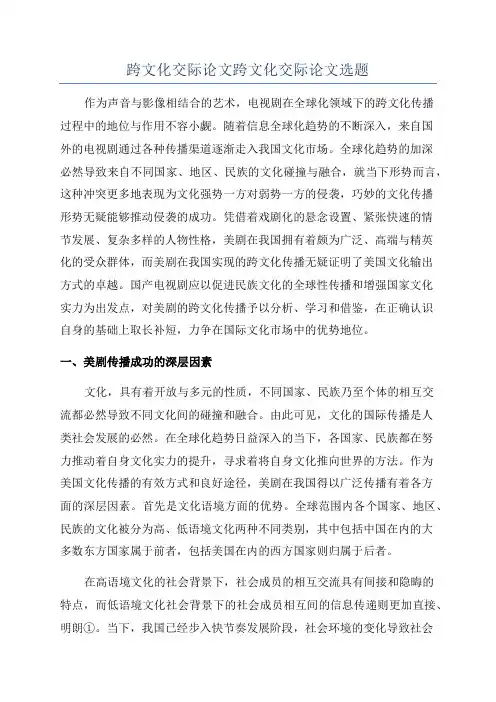
跨文化交际论文跨文化交际论文选题作为声音与影像相结合的艺术,电视剧在全球化领域下的跨文化传播过程中的地位与作用不容小觑。
随着信息全球化趋势的不断深入,来自国外的电视剧通过各种传播渠道逐渐走入我国文化市场。
全球化趋势的加深必然导致来自不同国家、地区、民族的文化碰撞与融合,就当下形势而言,这种冲突更多地表现为文化强势一方对弱势一方的侵袭,巧妙的文化传播形势无疑能够推动侵袭的成功。
凭借着戏剧化的悬念设置、紧张快速的情节发展、复杂多样的人物性格,美剧在我国拥有着颇为广泛、高端与精英化的受众群体,而美剧在我国实现的跨文化传播无疑证明了美国文化输出方式的卓越。
国产电视剧应以促进民族文化的全球性传播和增强国家文化实力为出发点,对美剧的跨文化传播予以分析、学习和借鉴,在正确认识自身的基础上取长补短,力争在国际文化市场中的优势地位。
一、美剧传播成功的深层因素文化,具有着开放与多元的性质,不同国家、民族乃至个体的相互交流都必然导致不同文化间的碰撞和融合。
由此可见,文化的国际传播是人类社会发展的必然。
在全球化趋势日益深入的当下,各国家、民族都在努力推动着自身文化实力的提升,寻求着将自身文化推向世界的方法。
作为美国文化传播的有效方式和良好途径,美剧在我国得以广泛传播有着各方面的深层因素。
首先是文化语境方面的优势。
全球范围内各个国家、地区、民族的文化被分为高、低语境文化两种不同类别,其中包括中国在内的大多数东方国家属于前者,包括美国在内的西方国家则归属于后者。
在高语境文化的社会背景下,社会成员的相互交流具有间接和隐晦的特点,而低语境文化社会背景下的社会成员相互间的信息传递则更加直接、明朗①。
当下,我国已经步入快节奏发展阶段,社会环境的变化导致社会成员愈加乐于直抒胸臆,而具有直接、明朗表达和交流等特点的美剧也就自然拥有了文化上的传播优势。
同时,美剧涉及的主题大都较为虚幻,诸如科幻、罪案、喜剧等同现实生活并无紧密关联,加之中美之间人民生活环境的较大差异,导致我国观众在观看美剧的过程中始终处于超脱现实的欣赏位置,并因其主观判断与现实功利色彩的脱节,能够保持更加宽容的态度,游戏性、体验性的观看在很大程度上消磨了异质文化传播可能产生的冲突和碰撞,使突破文化屏障的跨文化传播得以顺利进行。
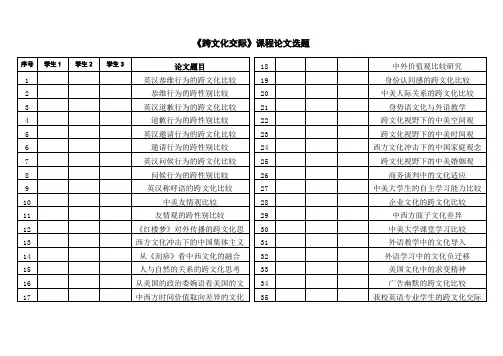
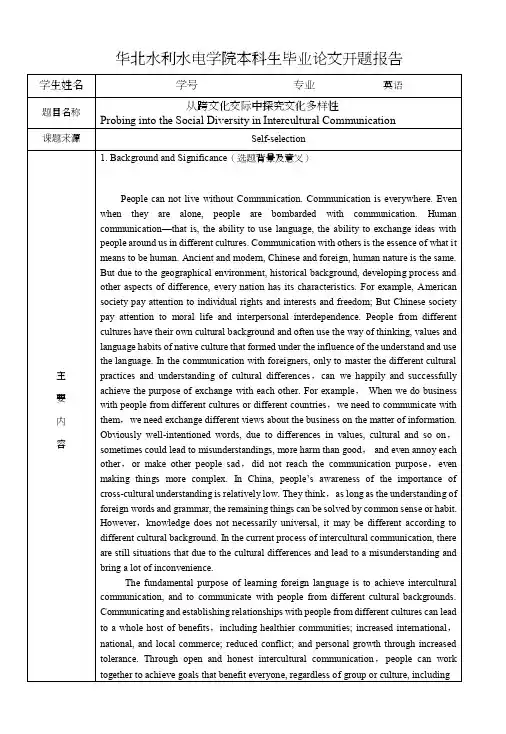
华北水利水电学院本科生毕业论文开题报告(Communication ) and the writings of foreign language and translation of the text is published in succession print,such as GuanShijie,s H Intercultural Communication",HuWenzhong.s" Intercultural Communication studies" and" cross cultural barrier -- Hu Wenzh ong‟s comparative cultural studies' GuoZhenzhi edited” globalization and culture”; Larry A . Samovar and Richard E. Porter Communication Across Cultures: A Reading photocopy edition has been in China issued,and Ma Zhengqi, and named the” cultural translation pattern and the dissemination way' In 1995, China has held the first session of intercultural communication seminar,conference was formed in intercultural communication research in China will be held in May2005, sixth sessions.Expected Achievements (预期成果与形成)The expected result of “Probing into the Social Diversity in Intercultural Communication” is to give a general and clear analysis on Social and Culture Diversity between Countries, carries on the analysis,and then write a qualified paper.Works Cited( ,15篇,格式按指导书里而的,格式不对的发回重改)[1]樊葳葳.跨文化交际教学研宂大观U].高等教育研宂,1999,(2).P1胡文仲.跨文化交际学概论[Ml.北京:外语教学与研宄出版社,1999: 42.林大津.跨文化交际研究[M].福州:福建人民出版社,1999李天辰.论跨文化交际研宄[几齐鲁学刊,1998,(10): 114〜117薛小梅.《语言?文化?跨文化交际》[N].光明日报,2003-05-27.16J王仕松.《交际英语》IMJ.北京:新世界出版社,2002-01f71Eugene A. Nida. Language and Culture --------- C ontexts in TranslatingfMl. Shanghai: Shanghai foreign Language Education Press,2002.[8]Ron scollon,Suzanne Wong Scollon. Intercultural Communication: A Discourse Approach [M ]. Beijing: Foreign Language Teaching and Research Press and Blackwell Publishers Ltd,2004.[91Gopaul-McNicol,Sharon -Ann Gopaul-McNicolJanet Brice-Baker. Cross-Cultural Practice: Assessment,treatment, and training. John Wiley and Sons. 1998 [10]Dueing,S.(ed.) The Cultural Studies Reader.London:Routledge, 1993 [1 lJTurner,Graeme.British Cultural Srudies. An Introduction,London and New-York: Routledge,1996f 12]Williams,R.Culture and Society . Harmondsworth:Penguin, 1963。
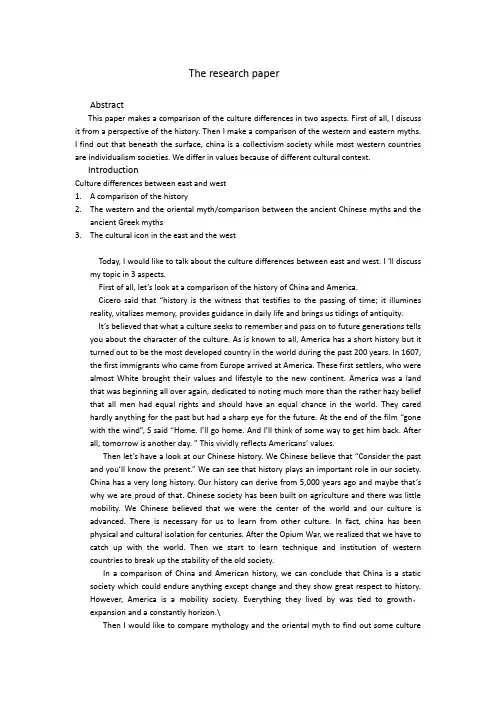
The research paperAbstractThis paper makes a comparison of the culture differences in two aspects. F irst of all, I discuss it from a perspective of the history. Then I make a comparison of the western and eastern myths.I find out that beneath the surface, china is a collectivism society while most western countries are individualism societies. We differ in values because of different cultural context.IntroductionCulture differences between east and west1. A comparison of the history2.The western and the oriental myth/comparison between the ancient Chinese myths and theancient Greek myths3.The cultural icon in the east and the westToday, I would like to talk about the culture differences between east and west. I ‘ll discuss my topic in 3 aspects.First of all, let’s look at a comparison of the history of China and America.Cicero said that “history is the witness that testifies to the passing of time; it illumines reality, vitalizes memory, provides guidance in daily life and brings us tidings of antiquity.It’s believed that what a culture seeks to remember and pass on to future generations tells you about the character of the culture. As is known to all, America has a short history but it turned out to be the most developed country in the world during the past 200 years. In 1607, the first immigrants who came from Europe arrived at America. These first settlers, who were almost White brought their values and lifestyle to the new continent. America was a land that was beginning all over again, dedicated to noting much more than the rather hazy belief that all men had equal rights and should have an equal chance in the world. They cared hardly anything for the past but had a sharp eye for the future. At the end of the film “gone with the wind”, S said “Home. I’ll go home. And I’ll think of some way to get him back. After all, tomorrow is another day. ” This vividly reflects Americans’ values.Then let’s have a look at our Chinese history. We Chinese believe that “Consider the past and you’ll know the present.” We can see that history plays an important role in our society.China has a very long history. Our history can derive from 5,000 years ago and maybe that’s why we are proud of that. Chinese society has been built on agriculture and there was little mobility. We Chinese believed that we were the center of the world and our culture is advanced. There is necessary for us to learn from other culture. In fact, china has been physical and cultural isolation for centuries. After the Opium War, we realized that we have to catch up with the world. Then we start to learn technique and institution of western countries to break up the stability of the old society.In a comparison of China and American history, we can conclude that China is a static society which could endure anything except change and they show great respect to history.However, America is a mobility society. Everything they lived by was tied to growth,expansion and a constantly horizon.\Then I would like to compare mythology and the oriental myth to find out some culturedifferences.We all know that myth potentially influences modern people’s life via deities and men’s stories from background, custom and some other aspects. China and Greece are birthplaces of orient and western civilizations. However, there are many differences between Chinese and Greek myth. These differences show our own unique national spirits and moral principles.Because of geographical location, china is the continental civilization while Greece is the marine civilization. These two totally different civilizations have great influence on people’s values and lifestyle.For example, the ancient deities play a perfect role in our Chinese myths like nvwa. In ancient times, the four corners of the sky collapsed and the world split open. The sky could not cover all the things under it. Human lived a miserable life. Then nvwa melted rocks of 5 colors and used them to mend the cracks in the sky.Moreover, in the story of dayu, he passed by his home 3 times but didn’t visit his wife. These deities usually take others into consideration. We can learn from the story that collectivism is the soul of Chinese.While in Greek myth, they put emphasis on individualism and venturesome spirit. From the beginning, the Greek myth was very bloody and violent. These gods took themselves into considerations first. Cronus killed his father and Zeus killed his father Cronus. It’s unbelievable to Chinese people. Deities and heroes in Greek myth are individualists except Prometheus. Prometheus is the god who created man, he also brought human the essential gift of fire. But soon after he brought fire to human, he was severely punished by Zeus. He was taken to the Caucasus Mountains. Zeus chained him naked to a rock. There a giant eagle tore at his liver during the day. Because Prometheus was immortal, his liver grew back during the night. Prometheus is the inspiration for all those people who refuse to bow to authority. Prometheus is an exception in Greek myth. Greek myth worships strength and individualism while we value virtue and collectivism.Through a comparison of the history and myth, we can find out that the culture differences between east and west. Most eastern countries are individualism societies. They value strength and venturesome spirit. We Chinese value collectivism, politeness and virtues. Although these cultural contexts have something in common, they vary greatly in other aspects.Bibliography[1] Ding wangdao , 100 Chinese Myths and Fantasies .Beijing, China Translation & Publishing Corporation and Commercial Press,1999[2] He daokuan ,Chinese Culture—A Description and Explanatory Approach .Beijing, Foreign Language Teaching and Research Press,1999.163--267[3] Powell Barry , Classical Myth. New Jersey, U.S.A,Pearson Education Company, 2001.106--129如有语法错误,请多包含o(∩_∩)o。

Intercultural Business CommunicationIntroduction:With the development of our social economic, a growing number of countries begin to cooperate with our country. At the same time, communication between two countries with different culture are increasing. So, we can often hear of misunderstandings caused by diversity in different culture. In order to avoid these, we need to understand different culture. Then, intercultural business communication turns up in our life. And it’s becoming more and more significant. In this paper, I’ll explain the importance by analyzing several typical cases in intercultural business communication.Body Part:Before analyzing these cases, we should understand context culture. Our country belongs to typical high context culture, and America belongs to low context culture. So Chinese people are very euphemistic to express their meaning, but American are so direct.When Mr.Wang firstly saw Mr. Green at the airplane, he smiled,’you must be very tire!’ Maybe M r. Wang just wanted to express his care about Mr. Green. But Mr. Green felt puzzled because of the diversity in cultures. He might thought that he left a bad impression on Mr. Wang and he felt a little sorry.Then in order to welcome Mr. Green, Mr. Wang treated him with a big dinner and said in a typical Chinese tone,”I’m very sorry that we’ve just prepared some poor food, I hope you don’t mind about it.’ These made Mr. Green very puzzled and he thought Mr. Wang was a dishonest guy because those were so good but Mr. wang apologized for this big dinner. But he didn’t know this was a modest expression.The next day, Mr. Green suggested that they should started their negotiation, but Mr. Wang advised him to travel in the city for several days. This time, Mr. Green refused his advice and said,” Business is business.”, which made Mr. Wang a little embarrassed. This is all because that Mr. Wa ng didn’t American culture. In America, people separate work from entertainment. When they work, they won’t waste time on entertainment. However, in China, people like to talk about work on table. We think that keep a good relationship is the first step to work, so we would like to spend much time on entertainment before work.Before they started their negotiation, Mr. Green noticed Mr. Wang took so many people with him. He felt very strange. He can’t understand that this was because the Chinese company attached significant on the cooperation. He thought, after all, this was just a business negotiation, not a big fight. Then Mr. Green introduced his mem bers to Mr. Wang,” This is my secretary and this is the lawyer of our company.” When hearing the word ‘lawyer’, all Ch inese people present felt uncomfortable and angry. Because in Chinese culture, lawyer is just like calculating family property in preparation for a divorce at a time when we are just beginning to fall in love. Mr. Wang just frowned and totally got no idea what to say. However, in American culture, in order to ensure two sides’ interest in a negotiation, a law yer is of the essence.During the negotiation, Mr. Green recommended several articles, but each time, Mr. W ang would just say,” Oh, that is very good, but I have to talk to my boss.” Mr. Green was very unplea sant, for he couldn’t understand why the comp any sent Mr. Wang if he couldn’t make any decision. He thought the Chinese company didn’t have the sincerity to cooperate with them. What’s worse, sometimes Mr. Wang even would give some puzzling answers, like” I fully understand this, but I am afraid ther e are some problems about this. It’s very complex.” For Chinese,we know those words mean that their idea had been refused . But for America, they didn’t understand, they thought that the Chinese company found some problems in their idea. So Mr. Green asked,” Then what are the problems?”. This made Mr. Wang embarrassed and hejust kept silent. At last, Mr. G reen couldn’t help losing his temper, and he totally believed that the Chinese company was really unwilling to cooperate with them. However, Mr. Wang di dn’t know why Mr. Green was so angry, so he said,” Take it easy. In fact, we do want to cooperate with your company, but you can see that things are complex.” Mr. Green was so angry to these cloudy words that he accidentally fell back onto the seat. In order to ease this embarrassed atmosphere, all the Chinese present laughed and asked,” Are you OK?”. Mr. Green said nothing and left the room for he thought he was not respected. But until he left China with his me mbers, he didn’t know why Mr. Wang treated him in such a way. Also, the Chinese didn’t know why Mr. Green was so angry.When they began their communication, they all ignored the diversity between their countries. They thought they had treated each other in their best way, but they didn’t reali ze t hat they used the wrong way. As a result, they didn’t cooperate with each other with misunderstandings.Conclusion:English, as a second language for us, is very important. Therefor, we learn English from primary school to college. But in the process, we are only taught how to use English, and never know the cultural diversity. However, when we communicate with English speakers, not only can we speak English, but also should we know the cultural diversity. So, for those reasons, intercultural business communication is very important for us. When communicating with foreign friends, we should know their custom, their speaking style, their culture and so on. Only in this way can we get their respect, friendship, cooperation and so on.Reference:1.廖华英2010 《跨文化交际案例分析》北京北京理工大学出版社。
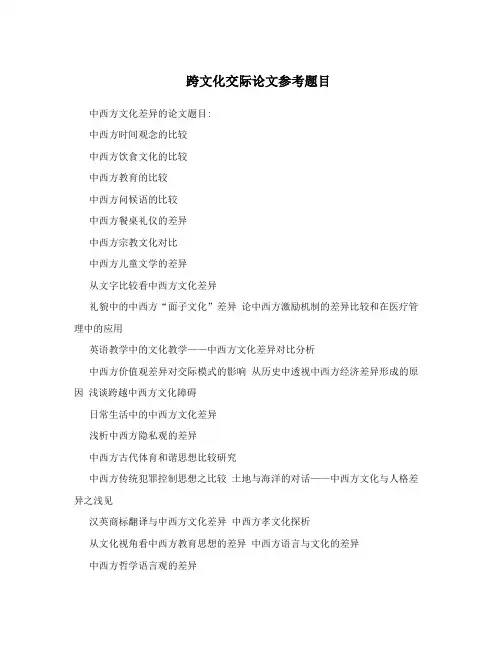
跨文化交际论文参考题目中西方文化差异的论文题目:中西方时间观念的比较中西方饮食文化的比较中西方教育的比较中西方问候语的比较中西方餐桌礼仪的差异中西方宗教文化对比中西方儿童文学的差异从文字比较看中西方文化差异礼貌中的中西方“面子文化”差异论中西方激励机制的差异比较和在医疗管理中的应用英语教学中的文化教学——中西方文化差异对比分析中西方价值观差异对交际模式的影响从历史中透视中西方经济差异形成的原因浅谈跨越中西方文化障碍日常生活中的中西方文化差异浅析中西方隐私观的差异中西方古代体育和谐思想比较研究中西方传统犯罪控制思想之比较土地与海洋的对话——中西方文化与人格差异之浅见汉英商标翻译与中西方文化差异中西方孝文化探析从文化视角看中西方教育思想的差异中西方语言与文化的差异中西方哲学语言观的差异浅析中西方文化差异对翻译的影响从素质教育看中西方教育的差异及思考中西方立宪文化差异比较——以价值观为视角影响跨文化交际的主要因素——中西方价值观念差异中西方股票期权制度实际操作的差异性分析英美社会与文化论文1. The Contrast and Analyses of Customsin Britain and China英国和中国习俗之研究2. Cultural Connotation of English Names 英语姓名的文化内涵3. Black Culture and American English 黑人文化与美国英语4. The Phenomenon of “PoliticalCorrectness” in American English论美国英语中的政治正确现象5. English Euphemism and Culture 文化因素与委婉语6. Cultural Differences in Address Terms: English and Chinese英汉称呼语中的文化差异7(Influence of Greek Myths to British and American Culture希腊神话与英美文化8. An Investigation on Intercultural Communication Competence and Intercultural Sensitivity Among Chinese College Students 关于中国大学生跨文化交际能力和跨文化敏感度的调查9. Cross-Cultural Awareness in Translating Tourist Materials中国旅游资料翻译中的跨文化意识10. Cross-Cultural Training in Chinese Universities中国大学中的跨文化培训11. Acculturation Strategies among Chinese Overseas Students中国海外留学生的文化适应策略12. On Tour Commentary Translation---An Intercultural Communication Perspective 从跨文化角度看导游词翻译13. Intercultural Communication on the Internet互联网上的跨文化交际14. On the Application of Theatrical Tricks tothe Shake speare’s Dramas论莎士比亚戏剧中的舞台技巧的应用15. The Bible and Western Festivals 《圣经》与西方节日16. On Culture-loaded Animal Words in Cross-Cultural Communication跨文化交际中的动物文化词研究17. The Cultural Differences Between Chinese and English from the Cultural Attached Meaning of Animal Words 从动物词汇看汉英文化的差异18. On Plants Words and Culture 论植物词汇与文化19. On the Cultural Connotations of Color Words in English and Chinese中英颜色词文化内涵研究20. Cross-cultural Communication on the Translation of the Chinese “Long”从中国“龙”字的翻译看跨文化交际21. On English and the Chinese Borrowing Words and the Cultural Differences 论中英借用词与文化差异22. A Contrast of the Symbols of American and Chinese Culture中美文化象征比较研究23. The Contrastive Study on the Courteous Expressions in English and Chinese 英汉礼貌用语对比研究24. Body Language in Non-verbal Communication浅谈非语言交际中的身势语25. Culture Consciousness in the English Language Teaching英语教学中的文化意识26. Reinforcing Equality in Cultural Communication in Cross-cultural Communication跨文化交际应加强文化平等交流意识27. Cross-cultural Difference on the Non-verbal Communication非言语交际的跨文化差异28. Improper Cultural Transferences in Cross-Cultural Communication文化负迁移对跨文化交际的影响29. On Cross-Cultural Communication Phenomenon论跨文化交际现象30. The Difference of Cultural Thinking Between English and Chinese and the Intercultural Communication英汉文化思维差异与跨文化交流31. Chief Factors Affecting Cross-Cultural Communication--- Difference Between Chinese and Western Values影响跨文化交际的主要因素---中西方价值观念差异32. Taboos in Cross-CulturalCommunication--- Probing into the Difference Between Western and Chinese Culture 跨文化交际中的禁忌问题---中西方文化差异之探讨33. Cultural Differences in Cross-Cultural Communication Between Chinese and English Language谈英汉跨文化交际中的文化差异34. The Difference of the Eastern and Western Mode of Thinking and Cross-Cultural Communication中西思维模式差异与跨文化差异35. Cross-Cultural Communication in Interpretation口译中的跨文化交流36. The Cultural Perception and Memory in Intercultural Communication跨文化交流中的文化感知和文化记忆37(Cultural Factors of English Catchwords英语流行语的文化因素38(The Epitome of Contemporary American History and Culture--- Interpreting Forrest Gump当代美国历史和文化的缩影---解读《阿甘正传》39. Body Language in Non-verbalCommunication浅谈非语言交际中的身势语40. Differences and Resources of Addressing in English英汉语中称谓的差异及其成因41. Cultural Interpretations of English and Chinese Names英汉姓名的文化阐释42. Different Body Languages in Different Cultures身势语在不同文化下的差异43. Functions of Non-verbal Behavior in Intercultural Communication非言语行为在跨文化交际中的功能44. The Contrastive Study on the Courteous Expressions in English and Chinese 英汉礼貌用语对比研究45. The Presentation of Different Thinking Modes in Chinese and Western Religious Cultures中西方宗教文化中的不同思维模式46. The Breath of American Slang美国俚语初探47. The Influences of Western Festivals on Chinese Society西方节日对中国社会的影响48. Cultural Migration of Western Festivals 西方节日的文化入侵49. The Influence of Borrowing Words on English and Chinese Vocabulary英汉词语互借对语言文化的影响50(Cross-Cultural Communication in Business World商务领域跨文化现象51(Christianity and American Culture 基督教与美国文化52. The Studies of Chinese Movies and Culture中国电影与文化53. Cultural Implication of Chinese Cuisine 中国饮食文化的内涵54. Diversities of Chinese and Western Culture from the Sources of English and Chinese Idioms从汉英习语来源看中西方文化的差异55. The Social Status of the Blacks in America after the Civil War美国内战后的黑人社会地位56. A Comparison of Garments Culture between the East and the West中西服饰文化对比57. A Research on Cross-Cultural Difficulties in Reading Comprehension影响阅读理解的跨文化因素研究58. The Reasons of Ancient Greek Mythology Influencing the English Language古希腊神话故事对英语语言影响的原因59. A Cultural Perspective on Chinese and Western Trademarks中西方商标的文化视角60(English Idioms and the Western Culture 英语习语和西方文化61. A Tentative Study on English and Chinese Euphemism汉英委婉语研究62(American Place Names and Their Culture 美国地名和文化63(A Comparison of Courtesy Conventions between Chinese and English 汉英礼貌用语的异同64(Animal Words in Chinese and English Idioms and Their Translations 中英习语动物词异同及其翻译65. Cultural Differences on Etiquette betweenChina and Western Countries中西方礼仪文化差异66(Increasing Cultural Awareness of Secondary School Students如何提升中学生的文化意识67(A Comparative Study of Compliments: Cross-Culture Perspectives 从跨文化的角度对比中西方问候语的差异下面的是2016年经典励志语录,需要的朋友可以欣赏,不需要的朋友下载后可以编辑删除~~谢谢~~1、有来路,没退路;留退路,是绝路。
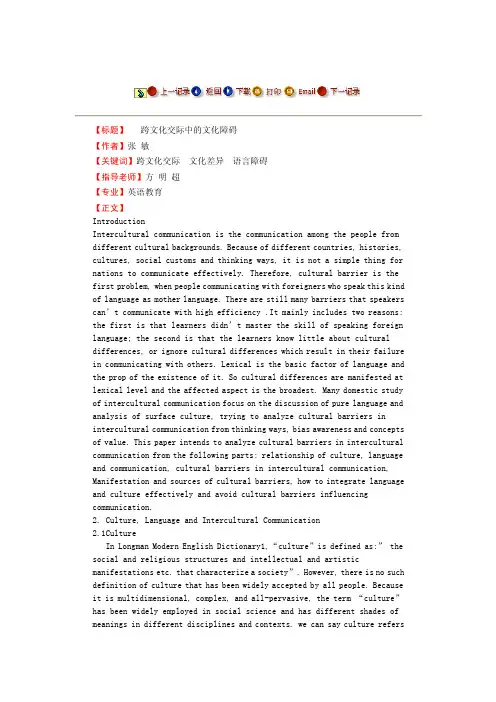
【标题】跨文化交际中的文化障碍【作者】张敏【关键词】跨文化交际文化差异语言障碍【指导老师】方明超【专业】英语教育【正文】IntroductionIntercultural communication is the communication among the people from different cultural backgrounds. Because of different countries, histories, cultures, social customs and thinking ways, it is not a simple thing for nations to communicate effectively. Therefore, cultural barrier is the first problem, when people communicating with foreigners who speak this kind of language as mother language. There are still many barriers that speakers can’t communicate with high efficiency .It mainly includes two reasons: the first is that learners didn’t master the skill of speaking foreign language; the second is that the learners know little about cultural differences, or ignore cultural differences which result in their failure in communicating with others. Lexical is the basic factor of language and the prop of the existence of it. So cultural differences are manifested at lexical level and the affected aspect is the broadest. Many domestic study of intercultural communication focus on the discussion of pure language and analysis of surface culture, trying to analyze cultural barriers in intercultural communication from thinking ways, bias awareness and concepts of value. This paper intends to analyze cultural barriers in intercultural communication from the following parts: relationship of culture, language and communication, cultural barriers in intercultural communication, Manifestation and sources of cultural barriers, how to integrate language and culture effectively and avoid cultural barriers influencing communication.2. Culture, Language and Intercultural Communication2.1CultureIn Longman Modern English Dictionary1,“culture”is defined as:” the social and religious structures and intellectual and artistic manifestations etc. that characterize a society”. However, there is no such definition of culture that has been widely accepted by all people. Because it is multidimensional, complex, and all-pervasive, the term “culture” has been widely employed in social science and has different shades of meanings in different disciplines and contexts. we can say culture refersto the whole of material and spiritual wealth created and accumulated by human beings in the course of social development. Material culture is concrete ,tangible and substantial, including cities, houses, organizations, etc. While spiritual culture is abstract, intangible and indiscernible, including values, beliefs and customs. Both material and spiritual culture play a major role in influencing people’s perceptions of reality, thought and behavior patterns. To put it simply, culture is the entire way of life of a society, the way of a people.For my purpose of the study of cultural barriers in intercultural communication, I would emphasize cultural barriers that most directly affected communication. Cultural barrier is the main problem of communicating under different cultural backgrounds, the first we should do is getting to know the definition of culture, and culture functions as an integrated whole—it is a system. A change in any aspect of culture will affect the others, especially the change in language.2.2 Intercultural CommunicationIntercultural communication is communication between two or more speakers who do not share the same cultural background. It occurs when a message sender is a member of one culture and a message receiver of another, intercultural communication can be problematic, and analyzing major components in communication help s clarify how communicative process works and how communication breakdown occurs.2.3 LanguageLanguage is a man’s principal means of communication. Man uses the language to express his/her thoughts, feelings and perceptions and wants to share them with other people. In this way man integrates himself/herself into a human group ,a member of human society.In linguistic sense,” A language is a system of arbitrary vocal symbo ls by means of which the member of a speech community communicates, interact, and transmit their culture.” According to Li Yanfu, whatever the definition of language is, it must include directly, or by close implication, the main attribute of language as follows: Language is related to culture.All languages have their own systems of pronunciation, vocabulary, and grammar: the reason why languages sound like gibberish is because we have not mastered the complexity of their system .However, mastering the linguistic rules wick not always guarantee the success of communication which is the central purpose of language. This is because language represents a kind of cultural phenomenon, and bears a cultural load and carries cultural information. To understand a language means to understand the cultural information it loads. In this sense, language is a subsystem of the culture system.2.4 The Relationship of Culture, Language and Intercultural Communication In the process of defining culture, communication and language, we find that they are tightly integrated with each other and anyone of them mayautomatically imply the other two.Culture and intercultural communication, they are two different concepts, but are directly linked. They are so inextricably bound. Culture is learned, acted out, transmitted, and preserved through communication. When culture differs, communication practices may also differ.Languages are at the core of intercultural communication and help human beings to reach out to make contact with others. By using the language, we let foreigners know how we experienced the world and what we think about that world.The relationship between language and culture is intrinsic2, for the language of a society is one aspect of its culture, in turn, has influence on language. According to sociolinguists, language is the keystone of culture. On the other hand, language is the chief means of learning a culture. People use it to express, share, and transmit their ideas and experiences. Furthermore, people become members of a particular community in process of learning and using the language of this community. Without language, culture would be impossible. According to anthropologists, culture comprises and shapes language. Different historical and cultural backgrounds, natural conditions and environment will lead to distinct interpretations and reactions to language3.Cultural Barriers in Intercultural CommunicationIn the previous part we have discussed that culture and language are very closely related, and one interacts another. When members of different cultures come together to share ideas and information cultural barriers act out which influence communication. In intercultural communication3, language may have some positive influence on the grounds that participants are alike partly and share some similar experiences. And this makes the interaction possibly. Language may also have some negative influence when participants are lack knowledge of each other and have difficulties in understanding people from different cultures. In this case, participants are likely to fall back on their own life experiences in their own pattern of thinking, or act in accordance with their own norms of social interaction. Simply speaking, cultural factors may result in cultural barriers in intercultural communication.As language learners, most of us asked:” What does that word mean?” This question reflects the way we viewlanguage .It suggests that we tend to look for meaning in words themselves, but we are incorrect if we think that words possess meaning It is more accurate to say that people possess meaning and that words elicit the meaning, because different people might bring their own world of experiences and associations into words, and it is normal for different people to attach different meanings to the same word. For instance, the image evoked by the word Peasant will be quite different in the mind of a Chinese and a westerner. For Chinese, a Peasant is just one of the numerous rural people working inthe countryside who deserve respect, while for westerners, the word helps form a picture of “a usually uneducated person of low socialstatus”(Webster’s Third new International Dictionary) or a rather rude, ignorant person.. Such difference in meaning inference suggests that memorizing some foreign words will not make us become the effective communicators unless learn the cultural meanings attached to them.It is clear that culture influences language meaning, let’s move to problems in meaning barriers. When people communicate cross-culturally, they are likely to encounter problems. Some words are generally considered commendatory in one language, but derogatory in the others. Let us see: the words like Idealism, Ambition, Aggressiveness, and Equalitarianism are negative in Chinese but positive or neutral to most Americans, while the words like Materialism, Politician, and Propaganda are negative or neutral in English but positive in Chinese. Obviously, these words should be used with due consideration. Since the meanings people assign to words are the result of their cultural experiences partly, they often lack applicable experience in encountering foreign words. The fact that terms in one language do not have counterparts in another language proves another great barrier in intercultural understanding.For the study of cultural barriers in intercultural communication, it is of great significance to look into meaning differences between selected English and Chinese terms. In this part, the discussion will be focused on the following concepts: idiom, proverb and motto.3.1 Idiom Meaning in Social and Cultural PerspectiveCultural barriers, first of all, each national culture has a lot of idioms. Therefore, some language elements often represent a nation itself and have certain peculiar ity4. Such as Chinese“胸有成竹,”it’s English explanation is have a well thought-out plan, stratagem, etc. If it was not explained clearly but explained directly: there is a bamboo planted in the heart, foreigners can’t understand the real cultural meaning of t his idiom. Another example,“邯郸学步”was explained directly to learning to walk in Handan, this kind of word combination obviously has no practical meaning. In Chinese, there are many similar idioms that developed from historical allusion ,ancient allegory and poetry, such as 叶公好龙,守株待兔,etc. it is difficult to express their meaning completely without annotation. Similarly, Helen of Troy in English means “红颜祸水”,it similar to“亡商之妲己”in ancient China ,if people of Chinese culture didn’t know the battle of Troy was caused by beautiful woman Helen, naturally they don’t know what it means. The another idiom came from Homer EpicsAchilles’heel,it infers small but fatal weakness,“if we don’t know the source of this kind of idiom and the cultural information itself providing, we can’t communicate with each other effectively.The other idioms, although express the same meaning in two languages, the homologous words are different. For instance, Chinese idiom “对牛弹琴,”the homologous English explanation is cast pearls before swine, but体壮如牛became 体壮如马:as strong as a horse; Chinese speak“吹牛,”but in English is talk horse, Chinese “牛饮”was explained to drink like a horse,“风马牛不相及”was explained to a horse of another color, etc. This phenomenon of cattle to horse is caused by different modals of production and thinking habit of the two nations, China is a industrial country since ancient times, cattle cultivate land play a important role in people’s life: but England is an island nation, the British mainly rely on horse in ancient times, cattle were used in producing milk, or a course, even so, the British still not mention cattle but only say I can cat a horse when they hungry. In addition, there are many idioms related to horse, such as horse doctor(蹩脚医生)horse laugh(纵声大笑) a dark horse (出人意料的胜出者)change horses(换班子)。
2017年上半年《跨文化交际概论》课程论文题目:从电影《女婿》看东西方跨文化交际的差异院系:文学与传媒学院专业班级:国教本16班学号:2016112543姓名:黄妍妍批阅教师:韦昌宁从电影《女婿》看东西方跨文化交际的差异世界之大,无奇不有,总是会存在着方方面面的差异。
而文化则是其中的一个方面。
所谓文化是通过某个民族的活动而表现出来的一种思维和行动方式,一种使这个民族不同于其他任何民族的方式。
而世界上大多数社会中都可能存在着若干群体或社团,这些群体或社团对地域、历史、生活方式及价值观等方面的共享,使其成员形成,发展并强化了自己独特的文化及与之相适应的交际文化。
对跨文化交际的概念可以这样界定:在特定的交际情景中,具有不同的文化背景的交际者使用同一种语言(母语或目的语)进行的口语交际。
这实际上是包含了许多不同的维面。
在跨文化交际中,有融合也会有冲突,这就需要做到求同存异。
最近,我看了一部有关跨文化交际的电影,名叫《女婿》,别名称《岳父岳母真难当》。
这是一部法国影片,初次听到这个名字,以为像国内家庭剧一样是无趣的,其实不然。
它的主题比较独特,是有关在跨文化交际背景下体现出东西方间的文化冲突。
该影片主要讲述的是一个信奉天主教的法国旧式传统资产阶级家庭中有四个女儿。
三个女儿分别找了阿拉伯、犹太和中国丈夫,有三种不同的跨国婚姻。
而老夫妻唯独期盼剩下未嫁的小女儿能找一个信奉天主教的法国白人,结果没想到小女儿找了一个非裔黑人。
在这对夫妻与他们的女儿女婿相处及在筹备小女儿婚礼的过程中,由于文化差异,产生了一些令人啼笑皆非和感动的故事。
该影片虽是一部轻松搞笑的家庭喜剧,但片中却处处体现出来自不同国家,不同宗教,不同种族的文化冲突和对于社会现实的抨击。
由此,可从这部影片中看出东西方跨文化交际的差异和从以下方面进行论述。
一.宗教方面(一)在影片里,玛丽问二女儿一家要为外孙取什么样的名字,犹太女婿笑称在安东尼,卢卡或穆罕默德三个名字间犹豫。
跨文化方向的英语专业论文题目1. "文化认同及其对跨文化交流的影响"2. "语言在跨文化理解中的角色"3. "全球化对文化认同的影响"4. "社交媒体对文化交流的影响"5. "文化多样性对商务交流的影响"6. "文化价值观在跨文化谈判中的作用"7. "隐喻在跨文化交流中的角色"8. "全球旅行对文化理解的影响"9. "电影和电视对文化理解的影响"10. "文化多样性对语言学习的影响"11. "艺术在跨文化交流中的角色"12. "科技对跨文化交流的影响"13. "全球化对文化价值观的影响"14. "国际移民对文化认同的影响"15. "旅游在促进文化理解中的作用"16. "全球媒体对文化表现的影响"17. "文化交流对语言变化的影响"18. "教育在促进文化理解中的作用"19. "全球事件对文化理解的影响"20. "文化多样性对社会凝聚力的影响"1. "跨文化交流中的语言障碍及其解决策略"2. "全球化背景下的文化冲突与融合"3. "社交媒体在跨文化交流中的作用及其影响"4. "文化差异对国际商务的影响及其应对"5. "艺术在跨文化交流中的角色及其影响"6. "科技在跨文化交流中的应用及其影响"7. "教育在促进跨文化理解中的作用"8. "全球事件对跨文化交流的影响及其应对"9. "跨文化团队的管理及其挑战"10. "跨文化交流中的非言语交流及其影响"11. "跨文化领导力及其对组织的影响"12. "跨文化交流中的文化适应策略"13. "跨文化交流中的文化翻译问题及其解决"14. "跨文化交流中的文化礼仪问题及其应对"15. "跨文化交流中的文化误解问题及其预防"16. "跨文化交流中的文化欣赏问题及其提高"17. "跨文化交流中的文化创新问题及其推动"18. "跨文化交流中的文化保护问题及其策略"19. "跨文化交流中的文化传播问题及其策略"20. "跨文化交流中的文化理解问题及其提高"。
跨文化交际论文选题简介随着全球化的发展,跨文化交际变得越来越重要。
在跨文化交际中,人们面临着来自不同文化背景的人的挑战与机遇。
因此,研究跨文化交际已经成为一个备受关注的领域。
本文将探讨跨文化交际的重要性,并提出一些研究论文选题,以促进对这一领域的研究。
背景跨文化交际是指在不同文化背景下进行交流和互动的过程。
在现代社会中,跨文化交际变得越来越普遍和重要。
全球化使不同国家和地区的人们更加频繁地进行交流和互动。
在这样的背景下,了解不同文化之间的差异和相似性变得至关重要。
跨文化交际既是一个挑战,也是一个机遇。
通过有效的跨文化交际,人们可以建立更好的人际关系,增进相互理解,并促进跨文化合作和交流。
选题一:跨文化沟通中的非语言交际非语言交际在跨文化交际中起着至关重要的作用。
不同文化对于非语言行为的理解和解读可能存在差异。
因此,研究跨文化沟通中的非语言交际是一个很有意义的选题。
可以探讨不同文化背景下的非语言行为习惯及其对沟通的影响。
例如,探讨不同文化中的肢体语言、面部表情和眼神交流等方面的差异和共同点。
选题二:文化价值观对跨文化交际的影响文化价值观是人们生活和行为的指导原则,也对跨文化交际产生深远影响。
不同文化之间的价值观差异可能导致沟通误解和冲突。
因此,研究不同文化背景下的文化价值观对跨文化交际的影响是一个有趣的选题。
可以探讨不同文化中的价值观差异,并研究这些差异如何影响人们的沟通方式、决策和行为。
选题三:跨文化团队合作中的问题与解决方案在全球化的背景下,跨文化团队合作变得越来越常见。
然而,由于文化差异和沟通障碍,跨文化团队合作面临诸多挑战。
因此,研究跨文化团队合作中的问题与解决方案是一个有意义的选题。
可以探讨不同文化背景下的团队合作模式、沟通方式和冲突解决策略。
同时,提出一些有效的解决方案,以促进跨文化团队合作的顺利进行。
结论跨文化交际是一个复杂而有趣的领域,对于促进不同文化之间的理解和合作至关重要。
本文提出了一些研究论文选题,包括跨文化沟通中的非语言交际、文化价值观对跨文化交际的影响以及跨文化团队合作中的问题与解决方案。
新疆大学外国语学院2013-2014学年第一学期期末论文跨文化交际论文题目:A study on Chinese Tea Culture and Western Coffee Culture专业班级:英语10-3班学生姓名:***学号:***********A study on Chinese Tea Culture andWestern Coffee CultureIntroductionAs a traditional and national drink of Chinese people, tea has never stepped out of Chinese people’s daily life. China is the homeland of tea. Chinese tea has a history of over 5,000 years, during which a series of unique tea culture have come into being. For Chinese people, tea is not only a necessity in their life, but also a symbol of the spiritual civilization of Chinese society.Coffee, like tea in China, is also a necessary drink in western countries.In the west, there’s a joke saying: “If I’m not in the coffee house, I will be on the way to the coffee house.” Westerners’ love for coffee has its own cultural background. Coffee also acts as a representative of western living pattern.Tea is to Chinese people what coffee is to westerners. They are not simply two kinds of popular drink, but also signs of two different cultures,that is, Chinese culture and western culture.The essence of tea culture is closely related to the values and thinking pattern of Chinese. Similarly, the spirit of coffee culture could not be parted from the western values and ways of thinking. The concept of tea in China varies from area to area, meanwhile, the habit of drinking coffee in the west also differs from country to country. In these years, as the development of globalization and the interpenetration of different cultures, tea and coffee are becoming more and more common all over the world. They has infused into each other. More and more people in China like drinking coffee, and more and more westerners become fans of Chinese tea.This paper consists of three chapters. The first chapter gives basic information and history of the Chinese tea culture.The second chapter talks about the introduction and history of western coffee culture. The third chapter focuses on the infusion of Chinese tea culture and western coffeeculture. At the end of this paper, the author draw a brief conclusion about the topic.Chapter 1 Chinese tea culture1.1 General introduction of Chinese tea cultureTea-drinking dates from Zhou Dynasty, and have been listed as one of the seven necessities in a day. In the long history of drinking tea, the ancients of Chinese people have developed an unmatched art of tea, that is tea culture.Chinese tea culture is the culture of making and drinking tea. As one of the open seven things (firewood, rice, oil, salt, sauce, vinegar and tea), Chinese tea can be categorized as green tea, black tea, wulong tea, white tea, yellow tea, scented tea, compressed tea(also called “dark tea”),and so on. The process of making tea and drink ing it are dainty in China, even the container of it are elaborately prepared, which form the basis of Chinese tea culture.The Chinese art of tea is not only a component of Chinese civilization, but also a miniature of the Chinese spirits refined in thousands of years of history.1.2 History of Chinese tea cultureThe original idea of tea is credited to the ancient Emperor, and the God of Agriculture, Shen Nong Shi. In the“Book of Herbs”, it says that “Shen Nong shi personally tasted hundreds of species of herbs and he was hit by 72 poisons in a single day. But he used a kind of three leaves to ease his case and it turned out to be tea tree.”It is said that tea shrubs were first discovered in the tropical and sub-tropical climate zone in the southwestern part of China, where primeval forests prevailed and the warm and moist setting was favorable for the growth of tea shrubs. That forms the basis for Chinese tea production.From the earliest times, tea was renowned for its properties as a healthy and refreshing drink. By the third century AD, many stories about tea and the benefits of teadrinking were being told, but it was not until Tang Dynasty (618 AD - 906 AD)that tea became China's national drink and the word “cha” was used to describe tea.As Buddhist priests in Tang Dynasty started to move around China and Japan, the spread of cultivation and tea drinking follows them.The first mention of tea outside China and Japan is said to be by the Arabs in 850 AD and it was they who were reputed to have brought it to Europe via the Venetians circa 1559.However,it is the Portuguese and Dutch who claim the credit of bringing tea and tea drinking to Europe. The Portuguese opened up the sea routes to China,some say as early as 1515. Jesuit priests traveling on the ships brought the tea drinking habit back to Portugal.1.3 the Chinese art of teaWhen talking about art of tea, Chinese “Chadao”(teaism)is an crucial part. It includes choosing the tea, selecting the water, tea technology, tea set art, choosing and creating the environment and so on, all of which need great attention and require a series of customs.As for the tea etiquette, different areas had different rules. Take gongfu tea (in Chinese means time-consuming) in Fujian province for example. Choose appropriate tea set. Normally, the tea vessels are small and exquisite, with the tea pot as small as a fist and tea cups as small as walnuts. Heat tea cups and teapot with hot water. Put tea leaves(about seven-tenth of the capacity) into the teapot. Pour the boiling water into the teapot with high-raised kettle. Keep pouring the boiling water on the teapot and teacups. Put the teacups in a circle, lower the teapot and pour the tea into the teacups. Preparing the tea. One should not fill the teacups one after another. Only two or three rounds of pouring should the teacups be filled with tea. This is to ensure that each teacup gets an even share of tea and each cup of tea has the sametaste, so that all drinkers would feel treated equally.The Chinese people, in their drinking of tea, place much s ignificance on the act of “savoring”. “Savoring” is not only a way to discern good tea from mediocre tea, but also how people take delight in their reverie and in tea-drinking itself. So, when drinking tea, one should first smell it, taste it, then drink it slowly. One should strictly follow the rules, otherwise, he/she would be regarded as ignorant of tea etiquette.Chapter 2 Western coffee culture2.1 General introduction of Western coffee cultureIn the west, there is a popular saying: “If I’m not in the coffee house, I will be on the way to the coffee house.” Though it is a simple joke, it reflects the importance of coffee for western people.Coffee grows in hot and more raining places, such as Brazil, Colombia. Their attitude to the life and others is very passionate, which also reflects in the coffee culture.Coffee culture describes a social atmosphere or series of associated social behaviors that depends heavily upon coffee, particularly as a social lubricant. The term also refers to the diffusion and adoption of coffee as a widely consumed stimulant by a culture. In the late 20th century, particularly in the Western world and urbanized centers around the globe, espresso has been an increasingly dominant form.2.2 History of western coffee cultureThe origin of coffee can be traced back to 100 million years ago. According to one story, the effect of coffee beans on behavior was noticed by a sheepherder from Ethiopia named Kaldi. He found his sheep unintentionally eating a kind of red fruit, the sheep became very lively and energetic.It helps people awake and later it is called coffee.Coffee has a history dating back to at least the 9th century. Originally discovered in Ethiopia, coffee beanswere brought into the Middle East by Arab traders, spreading to Egypt, Yemen, Persia, Turkey and North Africa by the 15th century. Muslin merchants eventually brought the beans to the thriving port city of Venice, where they sold them to wealthy Italian buyers. Soon, the Dutch began importing and growing coffee in places like Java and Ceylon, and the British East India Trading Company was popularizing the beverage in England. Coffee spread across Europe and even reached America.2.3 The western art of coffeeMaking coffee should have been a simple task. People only need bake coffee bean and cut into powder, and then pour hot water. But different people have different habits, and they always add others, such as milk or sugar. So various kinds of coffee were produced.When placing coffee cup and coffee plate, they should be placed in front of the drinker. And the hand of the cup should be right ward. When you are drinking coffee, you can use your right hand to hold the hand of the coffee cup and use your left hand to hold the plate. When you are mixing with the granulated sugar, you can directly use the spoon. But when you are drinking coffee, it should be taken out. If the coffee is hot, you can use the coffee spoon in the cup to mix round coffee or just wait till it is cool and then drink.The most important point is, when drinking coffee one can not run away or keep talking and can not add sugar for others without permission or pour coffee for yourself or others without permission of the hostess, because it is her work.Chapter 3 The infusion of Chinese tea culture and western coffee culture3.1 The popularity of tea in the westSince the tea has been imported to the western countries, it is more and more popular with the people. And different kinds of tea ceremonies and products are formed.Tea time serves as a time out to think, talk to friends or simply sit back and relax. In some cultures tea time is aceremonial time based on tradition of many years such as in the Far East. As the popularity of tea in western countries, “tea time” roots in people’s mind.However, the western tea culture is different from the Chinese one. They often drink tea with milk and sugar, and some snacks. And “Mix and Match” become more and more popular in nowadays, some of the stores mix up tea, milk and coffee. This new kind drink is popular among the young.3.2 The popularity of coffee in ChinaCoffee, at the same time,also gains great popularity in China. More and more young lovers choose coffee bars as their dating place. Also, more and more business negotiations are taken place in coffee houses. In the 1980s, t he world’s largest food company, Nestl e, introduced instant coffee to China. It is the beginning of popularity of instant coffee in China. Instant coffee is common because it is quicker. The small packs of instant coffee can be carried around and sucked on every five minutes. It is convenient for people to enjoy coffee anywhere anytime. ConclusionChina has formed its own tea culture for thousands of years, and Chinese tea has become an indispensable and important part in people’s daily lives. Similarly, western coffee also has cultivated its own culture in a long history. Today, tea and coffee rank as the first two natural beverages in the word, and with the economic globalization and the integration of cultures, economy and politics all over the world, tea can be found in western countries and meanwhile, coffee appears in China.In this paper, the author studies the history and art of both Chinese tea and western coffee, showing the unique features of both culture. Globalization has made the world smaller and smaller, and linked up the cultural characteristics of the entire humanity. We learn from each other’s culture and understand its values, which can contribute a lot to our intercultural communication.。
1. 英文原声电影赏析与跨文化交际能力的培养
2. 跨文化非语言交际语用失误研究
3. 公示语翻译中的语用失误探析
4. 国内广告语言语用失误研究现状与分析
5. 全球化语境下跨文化交际失误语用归因
6. 跨文化交际中的语用失误类型及对策研究
7. 基于礼貌原则的跨文化语用失误分析
8. 跨文化言语交际中的语用负迁移
9. 浅析化妆品广告中的语用预设 10. 中西方饮食文化的比较研究 11. 中美时间观之对比
12. 浅析汉英问候语中的文化差异 13. 英汉词汇的文化内涵差异探析 14. 英语身体语的交际功能研究
15. 浅谈英汉身势语的表意功能之差异 16. 目标语文化的理解与跨文化交际
17. 中西文化差异对中国学生英语学生的影响 18. 跨文化交际中的文化误读
19. 浅析文化差异对商务谈判的影响 20. 英语禁忌语的文化内涵异同研究 21. 英语学习中的文化习得
22. 英汉思维模式的差异对跨文化交际的影响 23. 外语学习者的思辨能力与跨文化交际之成效 24. 培养英语学习者跨文化交际能力之策略 25. 英汉道歉语差异及原因 26. 中西跨文化礼貌语差异探析 27. 英汉语言中礼貌表达法之比较 28. 英汉习惯用语的文化内涵探源 29. 英语称赞语及其回应的异同研究
30. 中美(西)家庭教育理念的差异及其对孩子的影响 31. 中国英语学习者跨文化交际中的主要障碍研究 32. 试析跨文化交际中角色互动的作用
33. 本土文化与异国文化的冲突对跨文化交际的影响 34. 跨文化交际中的时间观差异 35. 论跨文化交际中的中西餐桌礼仪
36. 关于提升英语专业学生跨文化交际能力的培养 37. 涉外婚姻中的中西文化冲突
38. 论跨文化广告传播中食品商标的翻译
4
39. 多媒体教学与跨文化交际能力的培养 40. 中西方儿童文学的差异
41. 中西体育文化的差异及其受全球化发展的影响 42. 中西传统休闲文化及其价值观的对比分析 43. 简爱与林黛玉不同命运的文化透析 44. 国际商务活动中礼貌原则的应用
45. 论文化背景知识在外语阅读教学中的作用 46. 国际商务交际活动中的非语言交际 47. 浅析英汉汽车商标的特点及其翻译 48. 英汉隐喻差异的文化阐释 49. 文化语境下的英汉植物词 50. 文化语境下的英汉动物词 51. 从体态语探析中西文化差异 52. 浅析英汉颜色词的文化内涵 53. 文化视野下英语谚语的比较 54. 从广告语言特色看中西文化异同 55. 从数字喜好看中西文化差异 56. 中西非语言行为的文化内涵探析
57. 从中英文动物比喻的不同看中西文化差异 58. 英汉概念隐喻的文化认知对比分析 59. 英汉成语文化内涵比较研究 60. 从神话看中西文化异同
61. 文化视角下英汉时间隐喻比较研究 62. 英汉情感隐喻文化内涵对比研究 63. 从文化语境看英汉爱情隐喻 64. 英汉动物隐喻的文化内涵
65. 论中英文中颜色隐喻的差异及其文化根源 66. 英汉习语中中西文化差异探源
67. 从英汉委婉语中看中西文化心理差异 68. 文化视阈中的汉英典故
69. 美国俚语的基本特征与社会功能 70. 从旅游广告看中西文化差异
71. 英语学习中中国文化缺失对跨文化交际能力的影响 72. 正视中西文化冲突提高跨文化交际能力 73. 从跨文化交际中的语用负迁移反思英语教学 74. 情境教学法在跨文化交际教学中的应用
75. 从跨文化交际的角度解读中西方礼貌准则和策略 76. 英汉委婉语及其在跨文化交际中的
作用 77. 跨文化中的归化和异化
78. 英语教学中学生跨文化交际能力的培养 79. 跨文化交际中的饮食文化差异
80. 从集体主义和个人主义看国际商务谈判的文化差异 81. 中英礼貌用语之差异
82. 过渡语僵化现象文化因素成因 83. 跨文化交际中的美国个人主义
84. 英汉隐喻的文化背景差异研究 85. 中英礼貌用语研究综述 86. 颜色词的文化内涵
87. 中国茶文化与西方咖啡文化对比研究 88. 汉英称谓语中的文化差异
89. 民俗风情游--中西“水”文化之比较 90. 跨文化商务谈判中的文化适应 91. 跨文化交际中的空间观 92. 英汉习语的文化差异分析
93. 当代中美女性婚姻观的比较研究 94. 中美商务谈判礼仪之礼貌用语比较
95. 从《老友记》看现代英语词汇中的语言性别差异现象 96. 解析麦当劳文化在中国的流行 97. 时间观差异在跨文化交际中的应用 98. 社会文化迁移对中国式英语的影响 99. 英语专业学生跨文化交际能力模式研究 100. 跨文化交际中中美时间取向的差异分析 101. 中国与英美国交际中的文化差异冲突案例研究 102. 从文化交际看动态对等翻译理论的指导性 103. 从中西人格差异看大学生跨文化交际能力的培养 104. 文化认知理论观照下的民族差异与汉语教育 105. 跨文化交际中的归化和异化翻译 106. 对大学新生公共英语教学的文化导入 107. 跨文化交际中语篇信息度的等级及其等级调控策略 108. 大学校园文化中的非言语交际形式剖析 109. 浅析汉英翻译中的文化因素 110. 浅谈跨文化交际中的文化多元化和文化冲击 111. 文化认同协商视角下的奥巴马总统就职演说 112. 浅论文化习得与跨文化交际能力的培养 113. 论文化意象与跨文化交际 114. 论文化图式跨文化交际与文化主体意识 115. 论文化融合与跨文化交际中的语言翻译 116. 论文化间性翻译理念对文化交际与发展的意义 117. 论文化和交际的多元性和能动性与跨文化交际学 118. 论文化负迁移与跨文化交际训练 119. 论文化定势与跨文化交际中认知能力和移情能力的培养 120. 论文化定势及偏见在跨文化非言语交际中的影响 121. 论文化定势对跨文化交际的影响 122. 论文化差异在跨文化交际中的作用 123. 论文化差异对跨文化交际的影响 124. 跨文化交际论文写作对差生大学英语学习影响的研究 125.从中英问候习俗和见面礼节论文化差异对跨文化交际的影响 126. 中外文化中恭维语语用差异与语用失误 127. 对外汉语教学中的语用能力培养 128. 试析中西习俗文化“冲突
6
129. 文化差异与跨文化交际能力的培养 130. 汉语跨文化交际教学的思考 131. 试析跨文化交际能力 132. 阅读理解中跨文化的意识 133. 跨文化交际中的饮食文化差异 134. 跨文化交际中的服饰文化差异 135. 肢体语言在跨文化交际中的应用 136. 试论跨文化交际语用失误137. 从色彩词汇看跨文化交际中的文化差异
138. 从“礼貌原则”看对外汉语教学中的跨文化交际 139. 试析跨文化交际中的非语言符号 140. 跨文化视野下的汉语词汇教学
141. 跨文化视野下的汉语语用教学交际文化与跨文化语言交际 142. 对外汉语教学中的文化教学原则 143. 对外汉语教学中的文化因素导入
144. 英语语言文化与汉语言文化之间对比分析(可选语音/词汇/语法/词汇/语用等某方面论述) 145. 不同语言颜色词的文化意义差异 146. 试析跨文化交际能力的培养
147. 汉语第二语言教学中文化因素的导入 148. 汉英翻译与文化的关系 149. 中英思维方式的比较 150. 汉英语言的对比
论文题目
1. 谈文化差异与跨文化交际能力的培养
2. 谈英语学习中跨文化交际能力的培养
3. 谈跨文化交际中的中英饮食文化差异
4. 英汉问候语差异比较
5. 茶与咖啡的文化差异
6. 从跨文化角度对比分析中英礼貌用语
7. 中西方文化中“面子”理论的差异
8. 中国与西方国家婚俗对比研究
9. 英汉颜色词的文化对比及其翻译
10. 跨文化交际中的中西方文化冲突
11. 谈跨文化非语言交际中的体态语
12. 英汉谚语中动物词汇的对比研究
13. 谈英汉称谓语差异的文化因素
14. 英汉习语的文化对比
15. 中西文化中数字的文化内涵浅析
16. 中西文化差异对跨文化交际的影响分析
17. 中西方委婉语中的文化差异分析
18. 中西方思维方式的差异及对跨文化交际的影响
19. 跨文化交际中的中西文化差异探析
20. 跨文化交际下的英汉禁忌语文化内涵研究
21. 沉默的跨文化对比分析
22. 中西文化中恭维语的语用差异与失误分析
23. 论中美饮食文化差异及其对跨文化交际的影响
要求:4000字左右,立论正确,结构清楚,格式规范,论述过程清晰、合理,语言通顺流畅。
禁止抄袭,否则以零分记!。